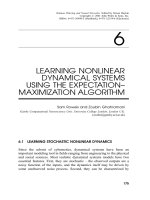Tài liệu Kalman Filtering and Neural Networks - Contents pptx
Bạn đang xem bản rút gọn của tài liệu. Xem và tải ngay bản đầy đủ của tài liệu tại đây (94.77 KB, 17 trang )
KALMAN FILTERING AND
NEURAL NETWORKS
Kalman Filtering and Neural Networks, Edited by Simon Haykin
Copyright # 2001 John Wiley & Sons, Inc.
ISBNs: 0-471-36998-5 (Hardback); 0-471-22154-6 (Electronic)
KALMAN FILTERING AND
NEURAL NETWORKS
Edited by
Simon Haykin
Communications Research Laboratory,
McMaster University, Hamilton, Ontario, Canada
A WILEY-INTERSCIENCE PUBLICATION
JOHN WILEY & SONS, INC.
New York = Chichester = Weinheim = Brisbane = Singapore = Toronto
Designations used by companies to distinguish their products are often claimed as
trademarks. In all instances where John Wiley & Sons, Inc., is aware of a claim, the
product names appear in initial capital or
ALL CAPITAL LETTERS
. Readers, however, should
contact the appropriate companies for more complete information regarding trademarks
and registration.
Copyright 2001 by John Wiley & Sons, Inc.. All rights reserved.
No part of this publication may be reproduced, stored in a retrieval system or transmitted
in any form or by any means, electronic or mechanical, including uploading,
downloading, printing, decompiling, recording or otherwise, except as permitted under
Sections 107 or 108 of the 1976 United States Copyright Act, without the prior written
permission of the Publisher. Requests to the Publisher for permission should be
addressed to the Permissions Department, John Wiley & Sons, Inc., 605 Third Avenue,
New York, NY 10158-0012, (212) 850-6011, fax (212) 850-6008,
E-Mail:
This publication is designed to provide accurate and authoritative information in regard to
the subject matter covered. It is sold with the understanding that the publisher is not
engaged in rendering professional services. If professional advice or other expert
assistance is required, the services of a competent professional person should be sought.
ISBN 0-471-22154-6
This title is also available in print as ISBN 0-471-36998-5.
For more information about Wiley products, visit our web site at www.Wiley.com.
CONTENTS
Preface xi
Contributors xiii
1 Kalman Filters 1
Simon Haykin
1.1 Introduction = 1
1.2 Optimum Estimates = 3
1.3 Kalman Filter = 5
1.4 Divergence Phenomenon: Square-Root Filtering = 10
1.5 Rauch–Tung–Striebel Smoother = 11
1.6 Extended Kalman Filter = 16
1.7 Summary = 20
References = 20
2 Parameter-Based Kalman Filter Training:
Theory and Implementation 23
Gintaras V. Puskorius and Lee A. Feldkamp
2.1 Introduction = 23
2.2 Network Architectures = 26
2.3 The EKF Procedure = 28
2.3.1 Global EKF Training = 29
2.3.2 Learning Rate and Scaled Cost Function = 31
2.3.3 Parameter Settings = 32
2.4 Decoupled EKF (DEKF) = 33
2.5 Multistream Training = 35
v
2.5.1 Some Insight into the Multistream Technique = 40
2.5.2 Advantages and Extensions of Multistream
Training = 42
2.6 Computational Considerations = 43
2.6.1 Derivative Calculations = 43
2.6.2 Computationally Efficient Formulations for
Multiple-Output Problems = 45
2.6.3 Avoiding Matrix Inversions = 46
2.6.4 Square-Root Filtering = 48
2.7 Other Extensions and Enhancements = 51
2.7.1 EKF Training with Constrained Weights = 51
2.7.2 EKF Training with an Entropic Cost Function = 54
2.7.3 EKF Training with Scalar Errors = 55
2.8 Automotive Applications of EKF Training = 57
2.8.1 Air=Fuel Ratio Control = 58
2.8.2 Idle Speed Control = 59
2.8.3 Sensor-Catalyst Modeling = 60
2.8.4 Engine Misfire Detection = 61
2.8.5 Vehicle Emissions Estimation = 62
2.9 Discussion = 63
2.9.1 Virtues of EKF Training = 63
2.9.2 Limitations of EKF Training = 64
2.9.3 Guidelines for Implementation and Use = 64
References = 65
3 Learning Shape and Motion from Image Sequences 69
Gaurav S. Patel, Sue Becker, and Ron Racine
3.1 Introduction = 69
3.2 Neurobiological and Perceptual Foundations of our Model = 70
3.3 Network Description = 71
3.4 Experiment 1 = 73
3.5 Experiment 2 = 74
3.6 Experiment 3 = 76
3.7 Discussion = 77
References = 81
vi
CONTENTS
4 Chaotic Dynamics 83
Gaurav S. Patel and Simon Haykin
4.1 Introduction = 83
4.2 Chaotic (Dynamic) Invariants = 84
4.3 Dynamic Reconstruction = 85
4.4 Modeling Numerically Generated Chaotic Time Series = 87
4.4.1 Logistic Map = 87
4.4.2 Ikeda Map = 91
4.4.3 Lorenz Attractor = 99
4.5 Nonlinear Dynamic Modeling of Real-World
Time Series = 106
4.5.1 Laser Intensity Pulsations = 106
4.5.2 Sea Clutter Data = 113
4.6 Discussion = 119
References = 121
5 Dual Extended Kalman Filter Methods 123
Eric A. Wan and Alex T. Nelson
5.1 Introduction = 123
5.2 Dual EKF – Prediction Error = 126
5.2.1 EKF – State Estimation = 127
5.2.2 EKF – Weight Estimation = 128
5.2.3 Dual Estimation = 130
5.3 A Probabilistic Perspective = 135
5.3.1 Joint Estimation Methods = 137
5.3.2 Marginal Estimation Methods = 140
5.3.3 Dual EKF Algorithms = 144
5.3.4 Joint EKF = 149
5.4 Dual EKF Variance Estimation = 149
5.5 Applications = 153
5.5.1 Noisy Time-Series Estimation and Prediction = 153
5.5.2 Economic Forecasting – Index of Industrial
Production = 155
5.5.3 Speech Enhancement = 157
5.6 Conclusions = 163
Acknowledgments = 164
CONTENTS
vii









